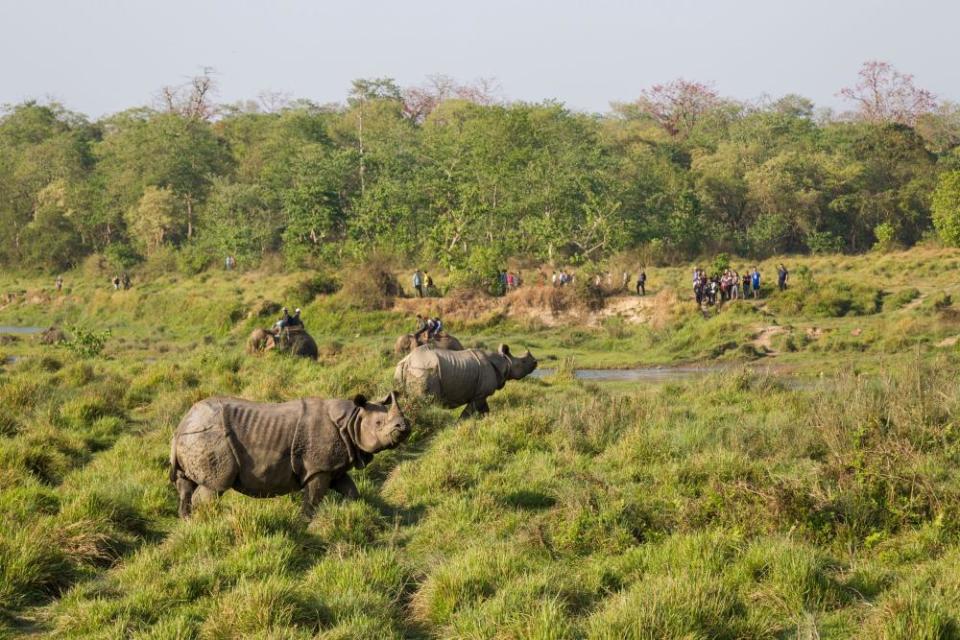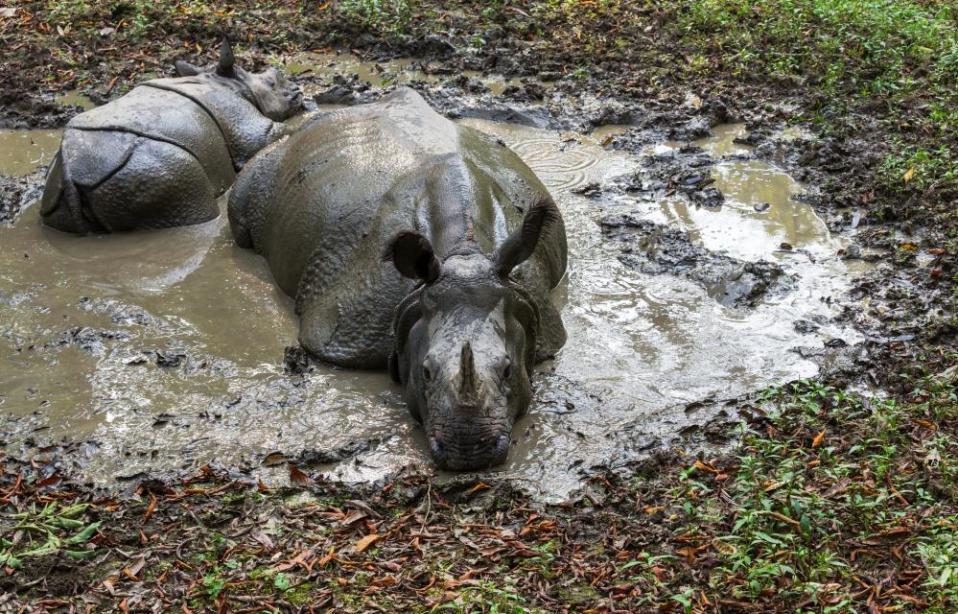Leading the charge: wildlife experts plan for future of Nepal’s rhinos

Ganesh Pant worries about the future. While he delights in the stunning conservation accomplishment that has seen the numbers of greater one-horned rhinos in Nepal jump from 100 in 1965 to 752 in 2021, he wants to be sure that success will continue.
Before the 1950s, as many as 1,000 rhinos roamed the grasslands and forests of Nepal. But by 1965, rampant hunting, poaching and changes in land use had brought the species close to extinction in the country. Then, the national park was established in 1973 and thanks to concerted conservation efforts, the rhino population began to bounce back.
Today, Chitwan national park has the second-largest concentration of one-horned rhinos after India’s Kaziranga national park, with the two parks accounting for 70% of the species’ global population. Besides playing a key role in the ecosystem, Chitwan’s rhinos help attract huge numbers of tourists each year, contributing considerably to the country’s economy. In 2019, there were 185,000 foreign visitors to the park.

But the greater one-horned rhino is still classified as vulnerable by the International Union for Conservation of Nature (IUCN), and a new threat has emerged. While there were only about five confirmed deaths due to poaching between 2016 and 2020, more than 100 rhinos were reported to have died of natural or unknown causes. “Poaching used to be the reason for rhino mortality. But in recent years, the government has done an excellent job in protecting rhinoceroses from poaching,” says Pant, a conservation officer working for the Department of National Parks and Wildlife Conservation in Nepal.
We are talking about adaptation because mitigation might take a long time … it’s not under our control
Ganesh Pant, conservation officer
“At this point, we cannot say that [these deaths are] only due to the impacts of climate change,” says Pant, who is studying for a PhD with the University of Southern Queensland, Australia. But he believes that the climate crisis could be one of the underlying causes. Pant and a team of researchers developed a set of 21 indicators to assess the vulnerability of the rhinos in Nepal to climate change. They concluded that they were “moderately vulnerable” to the impacts of global warming, primarily due to the likelihood of invasive species and extreme flooding in prime rhino habitat, along with habitat fragmentation, droughts and forest fires.
“I’ve tried to look at the likely shift in the habitat of the rhinoceros in Nepal in the next 50 years in different climate change scenarios,” he says. “And to find out what would be the adaptation measures – to enhance the resilience of the rhinoceros in the context of likely impacts of climate change.”

Rhinos are a highly adaptive species, hence their categorisation as moderately vulnerable. “That means it’s not at risk of immediate extinction due to climate change, but we have to consider it at the moment if we are to sustain the population for the long run,” says Pant.
Wendy Foden, a conservation biologist, agrees: “We are currently experiencing the fastest rate of climatic change in 65m years. If conservation planning efforts are to remain relevant and strategic, they must include the best available science on anticipated future impacts.”
Recent studies have shown several species of animals are already feeling the impact and are responding by shifting their habitats and even growing appendages or larger beaks, legs and ears to better regulate their body temperature in some cases. However, predicting the effects of the climate crisis on biodiversity is a challenge, in part because of the lack of long-term observational data.
Our biosphere – the thin film of life on the surface of our planet – is being destabilised by temperature change. Extreme weather events are becoming more common, with flooding, sea level rises, droughts and storms all affecting biodiversity and its ability to support us. In the ocean, heatwaves and acidification are stressing organisms and ecosystems already under pressure from human activities such as overfishing and habitat fragmentation.
The landmark Intergovernmental Panel on Climate Change (IPCC) report showed that extreme heatwaves that would usually happen every 50 years are already happening every decade. If warming is kept to 1.5C these will happen approximately every five years.
The effect of the climate crisis on the Earth’s biodiversity is already being seen. The distributions of 47% of land-based flightless mammals and almost a quarter of threatened birds may already have been negatively affected by the climate crisis, the IPBES (Intergovernmental Science-Policy Platform on Biodiversity and Ecosystem Services) warns. Five per cent of species are at risk of extinction from 2C warming, climbing to 16% with a 4.3C rise.
Scientists increasingly argue the climate and biodiversity crises are linked. The destruction of the planet’s carbon-rich habitats, such as peatlands, forests, wetlands and grasslands, is damaging biodiversity and releasing vast amounts of greenhouse gases.
If 15% of the world’s most degraded land was restored, and the remaining habitats which are still in good condition protected, it could store a third of all greenhouse gas emissions created by humans since the Industrial Revolution, according to researchers.
“It would be very unwise to plan species conservation actions before thoroughly assessing what can go wrong for that species, the mechanisms of potential impacts, how sensitive it is to these, and whether it is likely to be able to adapt of its own accord,” says Foden, who chairs the IUCN Species Survival Commission’s climate change specialist group, and led the development of IUCN guidelines for assessing species vulnerability to climate change.
“These provide the foundations from which to build solid conservation plans. So in most cases, climate change vulnerability analysis is imperative for species conservation planning.”

Pant’s research looked at the one-horned rhino’s climate crisis vulnerability according to sensitivity, exposure and adaptive capacity. Sensitivity is how strongly a species is likely to be affected by climate change; exposure is the extent to which their physical environment will change; and adaptive capacity is their ability to overcome the negative impacts of climate change.
While the one-horned rhinos fared well in the climate change vulnerability analysis, the changing climate is already threatening the rhino population in Chitwan national park. The species is dependent on a certain level of annual flooding to maintain its habitat.
But over the last few years, extreme flooding has affected the park several times, sweeping rhinos downstream into India and bringing debris and rubbish from upstream. Drought is also occurring more often, leading to fewer of the ponds that rhinos wallow in to regulate their temperature. Invasive species such as the bitter vine (Mikania micrantha), and Chromolaena odorata, a flowering shrub also known as Siam weed, are spreading at an alarming pace, encroaching into the grasslands that are the rhinos’ prime habitat. Global heating is expected to exacerbate extreme flooding and prolonged droughts, as well as the rapid growth of invasive species in the future.

According to Naresh Subedi, conservation programme manager at Nepal’s National Trust for Nature Conservation, better population and habitat management are crucial in the fight against the climate crisis. “Currently, our rhino population increment rate is 5%, for example. If we maintain 8% rhino population increment annually, then even if we lose 3% of the rhino population by the annual flood or climate-induced incident, they still will be in a good position.”
Pant agrees, noting that while floods are only seasonal, maintaining a suitable habitat all year is vital to sustain a healthy population. Another recent study by his team found that more than a third of rhinoceros habitat in Nepal could become unsuitable within 50 years due to mostly to climactic changes, but also land use changes.
Related: Rising tide: why the crocodile-like gharial is returning to India's rivers
Pant has proposed seven adaptation measures to secure the one-horned rhino’s future that include: maintaining the ponds rhinos need for wallowing; managing the impacts of floods; creating “refugia”; and actively managing habitats to provide a mosaic of grasslands and wetlands.
“We are talking about adaptation because mitigation might take a long time and also depends on several factors,” says Pant. “It’s not under our control, so the only thing we can do is safeguard the rhinoceros under these extreme conditions. That’s our priority at the moment.”
Find more age of extinction coverage here, and follow biodiversity reporters Phoebe Weston and Patrick Greenfield on Twitter for all the latest news and features


